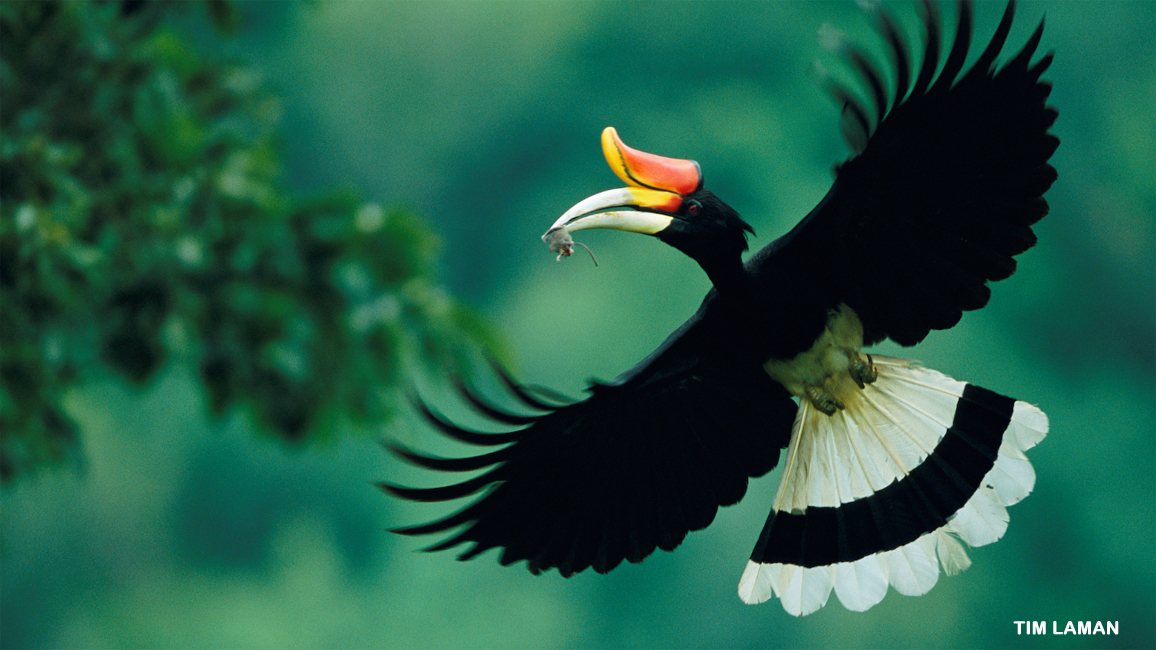
Hooked on Hornbills
By Ellen Lambeth; Photos by Tim Laman
What’s that big black-and-white bird flying in overhead?
It’s a male rhinoceros hornbill, delivering a mousy meal to his mate or a growing chick. Meanwhile, three others of its kind perch high in a tree in their rainforest home (above).
The rhinoceros hornbill is just one of nearly 60 species of hornbills in the world. Different kinds live in different parts of tropical Asia and Africa (see map on page 11). The body of the smallest species is about as long as a ruler, while the largest can be longer than a yardstick. The feathers of most come in patterns of black, white, gray, or brown. But their heads can be very colorful. Speaking of which, see that weird reddish thing on each bird’s head? That’s a huge clue you’re looking at a hornbill! Keep reading for more on that—and for the rest of the story.

It’s All About the Bill
The scientific name for this family of birds comes from an ancient word that means “cow horn.” A hornbill’s big bill is shaped like the curved horn on a cow, isn’t it?
The bill also comes with additional decoration: a casque (KASK). Remember the slipper-shaped thing on the rhinoceros hornbill’s bill? Now check out the different hornbills on these pages.
As you can see, their casques come in all shapes, sizes, and colors, depending on the species. On most hornbills, the casques are hollow and lightweight. And what does a hornbill use its casque for? Maybe it helps attract a mate. Perhaps it works as a megaphone for the bird’s call. Or it may be useful for headbutting a rival. But no one knows for sure.
As for the bill itself, it’s just the right size and shape for reaching toward and nabbing food.
What’s for Supper?
Hornbills eat lots of different things, from fruits to small creatures such as insects, mice, and snakes. A forest-dwelling hornbill probably eats mostly figs and other tree fruits. It plucks a piece of fruit with the tips of its bill and tosses it up in the air with a quick jerk of the head. Then the bird opens the bill wide to let the fruit fall down its throat. And here’s the good news: The fruit’s seeds pass straight through the bird and out in its droppings. Presto, new trees get planted throughout the forest!
Holed Up
One of the strangest things about hornbills is the way most of them raise their families.
First, a hornbill pair finds a suitable hole (usually in a tree) and makes a nest inside. After mating, the birds start to seal up the entrance to the hole—with the mother bird inside! They use whatever is available (mud, their own droppings, thrown-up fruit) to make the “cement.” Finally, only a narrow slit is left, just big enough for the father bird to pass food through. Mom will stay holed up in this predator-proof nest for months, caring for her eggs and then chicks. Eventually, she’ll dig their way out. But in the meantime, Dad stays busy grabbing and bringing home the meals. The family’s survival now depends entirely on him.

Rare Birds
Endangered helmeted hornbills need lot s of continuous forest with plenty of tree fruits to eat and large trees for nesting. But their forest homes are quickly disappearing as people cut down the big trees for lumber or to clear the land for farming. Even worse, too many of the birds are killed for their casques.
The casques aren’t hollow like those of other hornbills. They’re part bone and part keratin (KAIR-uh-tin), the same stuff your hair and nails are made of. The keratin is soft enough to be cut into buttons, decorations, or fancy carvings. Of course, that’s bad news for the birds!
But not all the news is bad. More and more people now realize how senseless it is to kill rare wildlife for no good reason. Also, some people who once captured and killed these birds are now helping scientists study and protect them, instead. With luck and hard work, this big bird might make a big comeback!
VIDEO: Watch helmeted hornbills in action!
Helmeted Hornbills
With a ghostly call and the loud whoosh of his massive wings, the bird above arrives at a hidden hole high up in a huge tree. Inside the hole are his mate and growing family. Without his regular food deliveries, the family would be doomed. And that’s just the tip of the story.
Takeout Order
A hungry helmeted mom has just enough room to poke her bill out of the sealed-up nest hole. Then Dad drops in food for her.
What a Waste!
Helmeted hornbills were killed so people could turn their heads into these carvings. But the heads were way more beautiful on living birds.
















